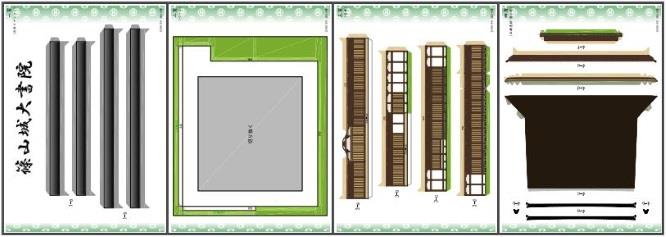These are the railway stations of Pleslin and Pleurtuit, new paper models created by my friend, the French designer and modeler Secanda. You will find many other unique paper models there, as can be seen on the last image of this post.
About the railway stations of Pleslin and Pleurtuit, Mr. Secand said: - "The Dinan-Dinard line was a single-track train line of about twenty kilometers. It was put into service in 1887. It was managed by the Ouest-État network and then, from 1938, by the SNCF. The passenger service was stopped in 1986 and the line was definitively closed in 1992. The rails have now been removed and the old track has been converted into a greenway.
In addition to its two terminus stations, the line had three small intermediate stations (Pleslin, Pleurtuit, Saint-Samson) plus a halt without significant infrastructure (Trémereuc). The passenger buildings (BV for Bâtiment Voyageurs in French) of the two most important intermediate stations on the line, those of Pleslin and Pleurtuit, still exist today but have been redesigned. That of Pleslin has been converted into a stopover gite and that of Pleurtuit is a part of the House of the local associations.
The BV of the small Saint-Samson station is now a private residence. The two BVs of Pleurtuit and Pleslin, of the "three-doors" type, are strictly identical, except for one detail: the inversion of the platform side and the city side.
The paper model therefore makes it possible to assemble one or other of these buildings, in their configuration from the beginning of the 20th century. Blank name plates and an alphabet are included in the model for possible personalization of the name plates by copy and paste."
Some curiosities about Secanda and his creative process, in his own words: - "Secanda means "stuff to cut" in Latin language. I use just an old basic multilayer photo editor, that I use as a paper with pencil and compass.
I don't use 3D editors because first I don't know at all how to use them and then I don't like very much the paper models made only with 3D tools. For my taste, they look often as nightclub mirror balls...
For my taste again, it's better to feel the hand of the drawer even if the result is rougher and less perfect. However the real reason is maybe I'm too lazy or too stupid or too old, or the three in the same time, to learn how to use a 3D editor."
"Many thanks, Secanda, for more one great model! Greetings from Brazil to France!" - Mauther
Estas são as estações ferroviárias de Pleslin e Pleurtuit, novos modelos de papel criados pelo meu amigo, o designer e modelista francês Secanda. Você vai encontrar muitos outros modelos exclusivos lá, como pode ser visto na última imagem deste post.
Sobre as estações ferroviárias de Pleslin e Pleurtuit, o Sr. Secand disse: - "A linha Dinan-Dinard era uma linha ferroviária de via única com cerca de vinte quilômetros. Entrou em serviço em 1887. Foi gerido pela rede Ouest-État e depois, a partir de 1938, pela SNCF. O serviço de passageiros foi interrompido em 1986 e a linha foi definitivamente fechada em 1992. Os trilhos foram removidos e a antiga via foi convertida em via verde.
Além das duas estações terminais, a linha contava com três pequenas estações intermediárias (Pleslin, Pleurtuit, Saint-Samson) mais uma parada sem infraestrutura significativa (Trémereuc). Os edifícios de passageiros (BV para Bâtiment Voyageurs em francês) das duas estações intermediárias mais importantes da linha, as de Pleslin e Pleurtuit, ainda existem hoje, mas foram redesenhados. O de Pleslin foi convertido em turismo rural de escala e o de Pleurtuit faz parte da Casa das associações locais.
O BV da pequena estação Saint-Samson é agora uma residência privada. Os dois BVs de Pleurtuit e Pleslin, do tipo "três portas", são estritamente idênticos, exceto por um detalhe: a inversão do lado da plataforma e do lado da cidade.
A maquete em papel permite assim montar um ou outro destes edifícios, na sua configuração do início do século XX. Placas de identificação em branco e um alfabeto estão incluídos no modelo para possível personalização das placas de identificação por meio de copiar e colar."
Algumas curiosidades sobre Secanda e seu processo criativo, nas palavras do próprio: - "Secanda significa "coisas para cortar" em latim. Eu uso apenas um velho editor de fotos básicas multicamadas, que uso como papel, lápis e compasso.
Eu não uso editores 3D porque primeiro eu não sei como usá-los e eu não gosto muito dos modelos de papel feitos apenas com ferramentas 3D. Para o meu gosto, eles parecem frequentemente com bolas espelhadas de discoteca ...
Na minha opinião novamente, é melhor sentir a mão no desenho, mesmo se o resultado for mais rude e menos perfeito. No entanto, a verdadeira razão é que talvez eu seja muito preguiçoso ou muito estúpido ou muito velho, ou os três ao mesmo tempo, para aprender como usar um editor 3D."
"Muito obrigado, Secanda, por mais um belo modelo! Saudações do Brasil à França!" - Mauther






























